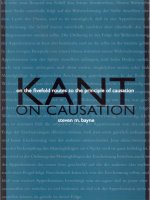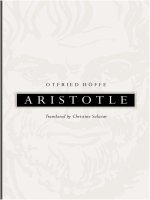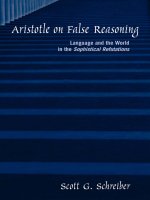state university of new york press aristotle on false reasoning language and the world in the sophistical refutations mar 2003
Bạn đang xem bản rút gọn của tài liệu. Xem và tải ngay bản đầy đủ của tài liệu tại đây (1001.85 KB, 265 trang )
Aristotle
on
False Reasoning
SUNY series
in
Ancient Greek Philosophy
Anthony Preus, editor
Aristotle
on
False Reasoning
Language and the World
in the Sophistical Refutations
Scott G. Schreiber
State University of New York Press
Published by
State University of New York Press, Albany
© 2003 State University of New York
Printed in the United States of America
No part of this book may be used or reproduced in any manner whatsoever
without written permission. No part of this book may be stored in a retrieval system
or transmitted in any form or by any means including electronic, electrostatic,
magnetic tape, mechanical, photocopying, recording, or otherwise
without the prior permission in writing of the publisher.
For information, address State University of New York Press,
90 State Street, Suite 700, Albany, NY 12207
Production by Michael Haggett
Marketing by Fran Keneston
Library of Congress Cataloging-in-Publication Data
Schreiber, Scott G. (Scott Gregory), 1952–
Aristotle on false reasoning : language and the world in the Sophistical refutations /
Scott G. Schreiber
p. cm. — (SUNY series in ancient Greek philosophy)
Includes bibliographical references and index.
ISBN 0-7914-5659-5 (alk. paper) — ISBN 0-7914-5660-9 (pbk. : alk. paper)
1. Aristotle. 2. Reasoning. 3. Fallacies (Logic) I. Title. II. Series.
B491.R4 S37 2003
185—dc21 2002030968
10987654321
To Sophia
™tm¥V gºr ÷sti t›V to£ Qeo£ dunºmewV
This page intentionally left blank.
Contents
List of Abbreviations xi
Preface xiii
Introduction: Reasoning and the Sophistical Refutations 1
Aristotle on the Kinds of Reasoning 1
The Sophistical Refutations 3
Outline of the Book 4
P
ART 1: FALLACIES DUE TO LANGUAGE
Chapter 1: The Power of Names 11
Naming Is Not Like Counting 11
“Counters” 13
“Signifiers” 14
Conclusion 18
Chapter 2: Homonymy and Amphiboly 19
Introduction: Aristotle’s Use of l°xiV 19
The Six Sources of False Reasoning Due to Language 20
Homonymy 21
Homonymy in the Categories 21
Homonymy in S.E. 22
Amphiboly 25
Amphiboly in S.E. 26
Amphiboly Outside the Organon 28
Problems with Aristotle’s Distinction: The Argument of S.E. 17 31
Conclusion 34
Chapter 3: Form of the Expression 37
Introduction 37
vii
viii CONTENTS
Form of the Expression As a Category Mistake 38
Confusion of Substance with Quantity 39
Confusion of Substance with Relative 40
Confusion of Substance with Quality 42
Confusion of Substance with Time 42
Confusion of Activity with “Being-Affected” 43
Confusion of Activity with Quality 44
Form of the Expression Fallacies That Are Not Category Mistakes 44
Confusion of a Particular with a Universal 44
Confusion of One Particular Substance with Another 45
Confusions Based on Gender Terminations 45
Form of the Expression and Solecism: Aristotle and Protagoras 48
Form of the Expression As a Linguistic Fallacy of Double Meaning 51
Chapter 4: Composition, Division, and Accent 55
Difficulties and Procedure 55
Fallacies Due to Accent 58
Fallacies Due to Composition and Division (C/D) 60
C/D Fallacies Are Not Examples of Double Meaning 60
The Primacy of Oral Speech 64
Further Examples 65
Confusing Linguistic Parts and Wholes 68
C/D Fallacies in the Rhetoric 72
Conclusion 74
P
ART 2: RESOLUTIONS OF FALSE ARGUMENTS
Chapter 5: Resolutions of False Arguments 79
Introduction 79
Principles of Aristotelian Analytical Method 80
Two Kinds of Resolution 82
The Principle of Parsimony 84
Proper Refutations and Their Defects: Ignoratio Elenchi 87
Resolutions of Fallacies Due to Language 88
How These Fallacies Violate the Definition of a Refutation 88
The Unity of Composition and Division: S.E. 23 90
The Extralinguistic Component of Resolutions
to Linguistic Fallacies 92
Contents ix
PART 3: FALLACIES OUTSIDE OF LANGUAGE
Chapter 6: Begging the Question and Non-Cause As Cause 97
Introduction 97
The Fallacy of Begging the Question 98
Begging the Question in the Prior Analytics 98
Begging the Question in Dialectical Reasoning 100
Begging the Question and Immediate Inferences 104
Resolutions 106
The Fallacy of Treating a Non-Cause As Cause 107
Conclusion 112
Chapter 7: Accident and Consequent 113
Introduction 113
Fallacies Due to Accident and Their Resolutions 114
False Resolutions to Fallacies Due to Accident 117
False Resolutions by Appeal to Linguistic Equivocation 117
False Resolutions by Appeal to Oblique Context 121
False Resolutions by Citing Missing Qualifications 123
Final Remarks on Double Meaning and Fallacies
Due to Accident 126
Historical Reasons for Treating Fallacies Due to
Accident As Errors of Logical Form 128
Fallacies Due to Consequent 130
Introduction 130
Aristotle’s Examples 132
Conclusion 139
Chapter 8: Secundum Quid 141
Introduction 141
Two Types of Secundum Quid Fallacy 142
Resolutions of Secundum Quid Fallacies 144
Secundum Quid As a Fallacy outside of Language:
Aristotle’s Position 145
Problems with Aristotle’s Position 148
Conclusion 150
Chapter 9: Many Questions 153
Introduction 153
xCONTENTS
Disjunctive and Conjunctive Premises 155
Disjunctive Premises 155
Conjunctive Premises 156
Resolutions of Fallacies Due to Many Questions 159
Homonymy and Amphiboly As Cases of Many Questions 161
Unity of Predication versus Unity of Definition:
The Problem of de Interpretatione 163
de Interpretatione 5 163
de Interpretatione 8 and 11 164
Conclusion 165
Conclusion and Summary 167
Appendix 1: Paralogisms in Aristotle 173
Appendix 2: Words and Counters—Platonic Antecedents 177
Appendix 3: Aristotle on k§rion Predication 179
Appendix 4: Platonic and Academic
Background to Secundum Quid 187
Notes 191
Bibliography 233
Index of Names 241
Subject Index 245
Contents xi
List of Abbreviations
The following are used to refer to the works of Aristotle:
Cael. On the Heavens
Cat. Categories
de Int. On Interpretation
EN Nicomachean Ethics
GA Generation of Animals
G.C. Generation and Corruption
HA History of Animals
Meta. Metaphysics
PA Parts of Animals
Phy. Physics
Poet. Poetics
Pol. Politics
Pr. An. Prior Analytics
Pst. An. Posterior Analytics
Rhet. Rhetoric
S.E. Sophistical Refutations
Top. Topics
xi
This page intentionally left blank.
Preface
My interest in Aristotle’s Sophistical Refutations was prompted by one extraor-
dinarily bold claim that he makes early in the treatise. He says that there are
twelve ways and only twelve ways by which false arguments can appear to be
persuasive. How could that be, I wondered. Does not the rich history of
human gullibility suggest a nearly unlimited number of ways that people can
be fooled into accepting poor arguments? But Aristotle rarely makes such
claims lightly. So began my close analysis of this treatise that purports to
argue for and illustrate exactly those twelve ways of producing false but per-
suasive arguments. Aristotle constructs his twelvefold classification of fallacies
from the perspective of the victim of the false reasoning. The question he asks
is this: What would explain why some person finds some piece of false rea-
soning persuasive? The victim of the sophism must hold some additional false
belief, either about language or about the world, which makes the false rea-
soning appear cogent to him. Aristotle’s twelvefold taxonomy of false argu-
ments, then, is based upon twelve types of false belief that lend persuasiveness
to bad arguments. And these false beliefs are not just about the mechanics of
proper logical form. For Aristotle, logical acumen alone is not enough to
safeguard one from sophistical arguments. One also must possess the right
meta-logical and metaphysical beliefs, and Aristotle believes that he has un-
covered the twelve false beliefs about language and the world whose correc-
tion will protect one from being taken in by false argumentation.
Aristotle’s classification of fallacies and his justification of that classification
in the Sophistical Refutations have received little systematic study in the twen-
tieth century. Such, however, was not always the case. From the early Greek
commentators, through the Latin schoolmen of the medieval period, and into
the nineteenth century, there had been a steady interest in the project of
creating a complete taxonomy of reasoning errors. Why did this interest wane
in the twentieth century? One factor is that the so-called linguistic turn in
xiii
the Anglo-American philosophic world could no longer seriously entertain
Aristotle’s chief taxonomical distinction between errors based on language
and errors based outside of language. The efforts of these philosophers, whether
proponents of ordinary or ideal language, were to resolve philosophic prob-
lems exclusively through linguistic clarification. The assumption that this
could be done left little sympathy for Aristotle’s claim that certain kinds of
false reasoning, themselves productive of philosophical perplexities needing
resolution, could only be resolved through metaphysical clarification.
This book returns, with considerable sympathy, to Aristotle’s project. My
goal is to make clear the philosophical justification that Aristotle presents for
his classification of fallacies. To do this, however, it is necessary to explore in
some detail the numerous examples of fallacies that Aristotle uses for illus-
tration. As happens so often in Aristotle, his examples can both clarify and
confuse. Much of this book involves a close analysis of these often-elliptical
illustrations of false reasoning. I recognize that there is a danger in treating
so closely all of these examples. The reader might begin to lose sight of
Aristotle’s big picture: his justification of the overall taxonomy. If one does
occasionally find oneself losing sight of the forest for the trees, I hope that
the trees themselves are sufficiently intriguing, providing peripheral insights
into other areas of logical theory and wider Aristotelian thought.
This need to concentrate on Aristotle’s examples explains two particular
features of the study: the extensive Greek citations and the sparing use of
non-English secondary sources. I have tried to keep the book as accessible as
possible to the “Greekless” reader. Much of what Aristotle says is very impor-
tant to readers interested primarily in the history of logic or in the growing
modern literature on informal fallacies. Accordingly, I have used my own
translations of all the Greek references. Nevertheless, I also have included
(most often in the notes) extensive citations of Aristotle’s Greek. I owe this
to those Greek readers of the book, because so many of Aristotle’s fallacies
are heavily dependent upon features of the Greek language. A further result
of this dependency is that any translation of Aristotle’s examples from Greek
into another language can have significant consequences of either clarifying
or obfuscating the fallacy being exemplified. Moreover, different modern lan-
guages will produce different transformations. What happens to Aristotle’s
examples when they are rendered into German or French adds a further layer
of difficulty for the English reader trying to grasp Aristotle’s theory. As a
consequence, I have restricted my secondary sources predominantly to those
written in English (the exceptions being the premodern Greek and Latin
commentators). I would be remiss, however, not to mention an important
addition to the modern scholarship on Aristotle’s Sophistical Refutations that
appeared late in 1995, after much of my own research had been completed.
Louis-Andre Dorion has published an extensive French translation of and
xiv PREFACE
commentary on the entire treatise as a volume in the J. Vrin series, Histoire
des Doctrines de l’Antiquité Classique. While my interpretations of Aristotle’s
examples sometimes differ from Dorion’s, readers interested in a line-by-line
commentary will find his study an important resource.
Preface xv
This page intentionally left blank.
Introduction
Reasoning and the Sophistical Refutations
ARISTOTLE ON THE KINDS OF REASONING
Central to Aristotle’s philosophic method is his analysis of reasoning or the
syllogism (sullogism¬V).
1
He defines a syllogism as “an argument in which,
when certain things are set down, something different from the things set
down follows necessarily by means of the things set down.”
2
In Topics I, 1,
Aristotle makes some preliminary distinctions among syllogisms. He divides
them into four types, differentiated by the character of the “things set down,”
that is, by the character of the premises. Demonstrative reasoning (™p¬deixiV)
proceeds from true and primary premises, appropriate to the particular sci-
ence, or else from theorems already derived from such true and primary
premises.
3
Dialectical reasoning (dialektik¬V) proceeds from common be-
liefs (⁄ndoxa), that is, premises believed by everyone or most people or by
certain wise people.
4
The third kind of reasoning is false reasoning, or “eristic”
(÷ristik¬V). The general mark of eristic is reasoning that appears to be what
it is not. Eristic falsely simulates other kinds of reasoning. Since the other
kinds of reasoning have been distinguished by the nature of their premises,
Aristotle initially defines eristic as reasoning from premises that are only
apparently endoxic but not really so. This would seem to restrict eristic to
apparent dialectical reasoning. Finally, there is false reasoning that simulates
demonstrative syllogisms. These paralogisms (paralogismo√) are related to
particular sciences but originate from false scientific premises.
5
The clearest way, then, to understand Topics I, 1, is as a fourfold
classification of syllogisms based entirely on the nature of the premises:
1. demonstrative reasoning from scientific premises,
2. dialectical reasoning from endoxic premises,
3. false reasoning (paralogisms) from premises only apparently
scientific; and
4. eristic reasoning from premises only apparently endoxic.
1
2INTRODUCTION
As neat as this arrangement looks in Topics I, 1, it is not Aristotle’s final
word on the kinds of reasoning. He proceeds to disrupt the scheme in two
ways. First, he distinguishes another type of reasoning called “peirastic”
(peirastik¬V), or examinational reasoning. Peirastic proceeds from some belief
of the person being examined. This sort of premise differs from a dialectical
premise in that (1) it must be believed by the person being examined (whereas
in dialectic, an endoxon may be posited for examination, which neither partici-
pant is committed to) and (2) it need not be an endoxon (i.e., it may be an
entirely idiosyncratic belief).
6
Peirastic is the closest successor to that Socratic
questioning that characterized the early Platonic dialogues: an examination of
someone’s claim to know something. Second and more important, even in
Topics I, 1, Aristotle wants to consider eristic as, more broadly, false or apparent
reasoning, not just reasoning from false or apparent premises, whether endoxic or
scientific. And so Aristotle finally settles on a disjunctive definition of eristic,
as either reasoning from only apparent endoxa or apparent reasoning, whether
from real or apparent endoxa.
7
This same definition is found in the S.E. intro-
duction to eristic: “reasonings from apparent but not real endoxa, or apparent
reasonings.”
8
For Aristotle, the mark of eristic is appearance. Eristic arguments simu-
late but fail to be real arguments. This characteristic of simulation also is
one that Aristotle applies to sophists and sophistry. For example, the soph-
ist trades on people’s inability to distinguish the true from the false, the real
from the merely apparent. He makes his living from his apparent wisdom
rather than any real wisdom.
9
Naturally, then, the source of the sophist’s
success is his expertise in eristic. But Aristotle’s sophist is more than a
master at apparent-but-not-real argumentation. He also can produce real
(i.e., valid) arguments that appear to be, but are not, relevant to the issue
at hand.
10
And so there are three sources of sophistical appearances in
argumentation: premises that appear to be what they are not, arguments that
appear to be valid when they are not, and valid arguments that appear to be
relevant to the matter at hand when they are not. Using these three appear-
ances, separately or in combination, the sophist derives his dangerous power
to deceive. But these same false appearances can arise even apart from the
intent of a sophist to deceive. One of the reasons for studying sophistical
arguments, says Aristotle, is that it better prepares the philosopher for con-
ducting his own private researches; for someone who can be deceived by
another person will be all the more easily deceived by the same sorts of
appearances when they arise in his own thinking.
11
How, then, does one learn
to recognize these false appearances, whether they are intended by another or
accidentally arise in one’s own study? Aristotle devotes his treatise, Sophistical
Refutations, to answering that question.
Introduction 3
THE SOPHISTICAL REFUTATIONS
Although the work Sophistical Refutations (S.E.) is sufficiently self-contained
to be labeled a “treatise,” Aristotle seems to have intended it as the closing
book to the Topics. So, for instance, in the Prior Analytics (65b16), he cites S.E.
167b21-36 under the title of the Topics. And the last chapter of S.E. is intended
as a conclusion to the whole of his treatments of both dialectic and eristic.
Nevertheless, the discussions of dialectic and eristic are clearly distinct and so
marked both in the beginning of the Topics (100a25-101a4) and in the intro-
duction to S.E. (164a20-22). In the later passage, Aristotle goes on to say that
elsewhere he has discussed didactic, dialectical, and peirastic argumentation, and
that now he must begin his treatment of eristic (S.E. 165a38–165b11).
12
Aristotle has two projects in S.E. The first is to identify the various
sources of false reasoning. The second is to provide the reasoner who encoun-
ters false reasoning the means to resolve the resultant confusion engendered
by the apparent but false argument. According to Aristotle, people fall victim
to false reasoning, whether in the course of a dialectical exchange with an-
other reasoner or in the privacy of their own reflections, from two general
sources. False arguments are either due to language (parΩ t‹n l°xin) or
outside of language (⁄xw t›V l°xewV). He further specifies six distinct linguis-
tic sources and six distinct extralinguistic sources. The diagram on the follow-
ing page shows Aristotle’s entire classification.
13
In S.E.4-11, Aristotle describes and illustrates each type of false reason-
ing, repeatedly affirming the inviolable distinction between the linguistic and
the extralinguistic sources of error. Commentators have not always received
this distinction kindly. Often the view has been that Aristotle’s division is
arbitrary. Many of the examples he cites to illustrate the different species
under these two principal headings seem to be just as easily categorized under
a different species from the other heading. One especially strong tendency
has been to see arguments outside of language as reducible to arguments due
to language.
14
One goal of this book is to show why Aristotle refuses to allow
such a reduction. His nonreductionist position is based upon his notion of a
resolution. Aristotle develops that notion in the second half of S.E.
In S.E. 16, Aristotle introduces his second concern: the problem of false
reasoning from the standpoint of the potential victim of the sophism rather
than from the standpoint of the perpetrator. His concern is with resolutions
(l§seiV) of sophistical arguments. The organization of his material on reso-
lutions parallels his earlier format. He devotes chapters to each of the types
of fallacies, both linguistic and extralinguistic, and he shows via examples and
commentary how each type is to be resolved. Aristotle requires for a resolu-
tion of a false argument two things. The resolution must explain why the false
4INTRODUCTION
argument is false, and it must explain why it appeared to be true. It is this
second explanation that plays a defining role in Aristotle’s typology of falla-
cies. Each example of false reasoning is persuasive only if the victim holds a
particular false presupposition about either language or the world. It is the
nature of that presupposition that determines where the example of false
reasoning is situated in Aristotle’s typology.
OUTLINE OF THE BOOK
Aristotle’s notion of a resolution goes a long way toward understanding his
distinction between linguistic and extralinguistic fallacies. There are, however,
other problems with his typology that the manner of resolution alone does
not solve. Particularly on the linguistic side of the basic dichotomy, some of
False Reasoning
Ignoratio Elenchi
Due to Language Outside of Language
Double Meaning Non-Double Meaning
Homonymy Accent Begging the Question
Amphiboly Composition Non-Cause As Cause
Form of the Expression Division Accident
Consequent
Secundum Quid
Many Questions
▼▼
▼
▼
▼
▼
▼
▼
Introduction 5
Aristotle’s examples raise their own peculiar difficulties. Accordingly, before
considering the role of resolutions in clarifying the distinction between lin-
guistic and extralinguistic fallacies, I analyze in part 1 Aristotle’s discussions
and illustrations of linguistically based fallacies. In chapter 1 I look at Aristotle’s
argument from S.E. 1, that there is a “power of names” to have multiple
signification. “Multiple signification,” however, turns out itself to have two
meanings that Aristotle fails to keep separate. On the one hand, universals
signify many different individuals as well as the universal under which the
individuals fall. This is the sense of multiple signification that Aristotle shows
in S.E. 1 to be unavoidable, given the nature and function of language. On
the other hand, some words signify different kinds of individuals rather than
just different individuals of the same kind. Both types of multivocity play
roles in the production of false reasoning.
In chapters 2 and 3 I analyze the first three types of fallacy “due to
language.” These are the three cases of what Aristotle calls “double meaning”:
fallacies due to homonymy, amphiboly, and the Form of the Expression. I
expose several problematic cases among Aristotle’s examples of these three
types. The chief source of the problems, I conclude, is Aristotle’s failure to
distinguish between the power of common nouns, on the one hand, both to
signify universals and to apply to many particulars (as discussed in chapter 1)
and, on the other hand, other kinds of multiple signification that he divides
among the three fallacy types. The ways he differentiates among homonymy,
amphiboly, and Form of the Expression are generally well defined and illus-
trated, until he tries to assign places among them to false reasonings based
upon that special power of common predicates. The result is that cases of the
multivocity of universal predicates end up being assigned to the various double
meaning fallacy types almost arbitrarily, thereby confusing the otherwise clearly
principled taxonomy. In the end I conclude that Aristotle, who fully appre-
ciates the multivocity of so many words, fails to see (at least in S.E.) the
multivocity of “multivocity.” In my concluding chapter I will propose a revi-
sion to Aristotle’s taxonomy that acknowledges the different kinds of verbal
multivocity.
In chapter 4 I analyze the three fallacy types “due to language” that are
not cases of double meaning: Composition, Division, and Accent. I argue that
these are fallacies primarily occurring in (fourth-century
B.C.) written Greek,
where the absence of internal sentence punctuation, accents, breathing marks,
and word divisions made it difficult for the reader to individuate separate
linguistic signifiers. The same sequence of component linguistic parts (e.g.,
phonemes, letters, words, etc.) may turn out to compose different linguistic
signifiers if enunciated differently. Errors due to Composition, Division, and
Accent arise when these different signifiers are mistakenly believed to be the
same signifier.
6INTRODUCTION
Part 2 is devoted to a general discussion of resolutions of fallacies. This
section serves as the axis around which the entire book rotates, for it is the
manner of resolution that determines the type of fallacy. Resolutions require
the identification of those false presuppositions whose correction is both nec-
essary and sufficient for the removal of the perplexity as to why the apparent
refutation is false and why it appears true. I conclude that Aristotle recognizes
three kinds of erroneous presupposition whose correction is able to resolve all
perplexities arising from false reasoning. These are false beliefs about parts of
language itself, false beliefs about the relationship language has to the realities
it signifies, and false beliefs about the extralinguistic world that is signified.
The characteristic of fallacies due to language is that their resolutions require
some correction of false presuppositions about the nature of language or how
language relates to the things it signifies. Resolutions of fallacies outside of
language, on the other hand, require no such corrections. This is not to say,
however, that the correction of errors about the nature and use of language
is sufficient to resolve linguistically based fallacies. Fallacies of double mean-
ing also derive their plausibility from particular false presuppositions about
the world.
Part 3 is an analysis of the six fallacy types that arise outside of language.
For each type I isolate that feature of the extralinguistic world that one must
understand if one is to avoid that fallacy. In chapter 6 I argue that, for
Aristotle, false reasonings due to Begging the Question and Non-Cause As
Cause derive their plausibility from mistaken beliefs about the proper ex-
planatory powers of nonlinguistic facts. In chapter 7 I discuss Aristotle’s
fallacy types of Accident and Consequent. I argue that Aristotle presents no
convincing argument or evidence for a distinction between the two types. The
common ontological mistake that renders examples of such fallacies appar-
ently sound is the confusion of accidental with essential predication. Chapter
8 deals with the fallacy of Secundum Quid. I argue that these fallacies can only
be resolved by correcting both false linguistic and false ontological presuppo-
sitions. Here is the most glaring taxonomic mistake in Aristotle’s scheme.
The need for some linguistic clarification should place these errors under
Aristotle’s heading of fallacies “due to language.” In chapter 9 I isolate two
extralinguistic errors promoting fallacies due to Many Questions. Sometimes
there is a false assumption that what is truly predicable of an ontological
whole or set also is truly predicable of each part of the whole or member of
the set. Even where this error is not in evidence, there remains a failure to
distinguish between states of affairs that are properly explanatory of some
conclusion and states of affairs that only logically entail that same conclusion.
In this chapter I also show that Aristotle concedes that linguistic fallacies of
double meaning presuppose the extralinguistic fallacy of Many Questions.
This leads to the conclusion that only the errors assigned to Composition,
Introduction 7
Division, and Accent arise entirely independent of some mistaken ontological
presupposition.
Most of the ancient and modern criticisms of Aristotle’s typology of false
reasonings suffer from a failure to appreciate the role of resolutions in the
construction of the overall taxonomy. What emerges by the end of the book
is an Aristotle whose systematic analysis of the types of false reasoning is,
despite a couple of unresolved problems, principled and nonarbitrary. It rests
upon a view of the world as intelligibly accessible to human understanding
through the medium of (Greek) language as it is. This is not to say that
language “as it is” (i.e., ordinary Greek language) is not, in both syntax and
semantics, full of deceptive pitfalls for the reasoning agent. But Aristotle
directs his efforts toward acquainting the human inquirer with ways to rec-
ognize those potential dangers rather than toward constructing an amended
language immune to such dangers. Among Aristotle’s requirements for rec-
ognizing false argumentation are commitments to a number of ontological
positions. Logic, as a general study of reasoning, is not metaphysically neutral
for Aristotle. He holds that there are substantive claims about the world that
must be accepted if one is to be able to distinguish between examples of true
and false reasoning.
This page intentionally left blank.









